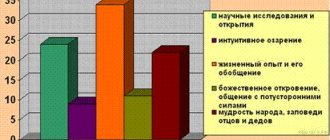Surely you have noticed that each child has individual characteristics in behavior, communication, and ways of reacting to external stimuli. If one kid “pulls the whole blanket over himself,” and the second is scrupulously busy with his work, without being distracted by anything, then the third dreamily watches what is happening... There are so many characters, so many people, but is it possible to find something in common and identify children of the same type? ?
Development and education of children from 2 to 11 years old in a playful way
Start practicing right now
Start practicing
It turns out yes. Among the diversity of individuals, similar qualities are identified, according to which all people can be divided into four groups according to the type of temperament: choleric, sanguine, melancholic and phlegmatic.
What is temperament, what does it look like, how to determine the type of temperament a child has and how adults can use this knowledge when communicating with children - we will talk about this in our article.
What is temperament? What is the difference between temperament and character?
Temperament is an innate combination of human properties, which manifests itself in the characteristics of behavior, reactions and ways of interacting with the outside world.
Depending on temperament, a person’s life can be colored by various emotions. It is believed that temperament, unlike character, is precisely an innate feature. However, over the course of life, many factors influence the way of thinking and behavior, people acquire the armor of life experience, which is why it is easier to determine and evaluate the temperament of a child than of an adult. Parents and teachers can and should learn to determine the type of temperament and use the knowledge gained to build the right strategy for communicating with children and their quality education.
The manifestation of temperament can be observed in all areas of life: the style of contacts with other people, reactions and attitudes to various events, the speed of information processing, the pace and types of thinking, and much more. Since temperament is a combination of mental and physiological characteristics, it is impossible to educate it, unlike character.
It is believed that temperament is one of many manifestations of character. While temperament is determined by the innate type of nervous organization, character is formed under the influence of the following environmental factors:
- family norm and way of life,
- parenting style,
- cultural environment,
- social status, etc.
The process of character formation continues throughout life, and a special role in this is played by the experience of a person’s interaction with society. Therefore, as a result, we can say that the type of temperament lays the foundation of character, and the life experience gained gives it more uniqueness and individuality.
What is human temperament?
In modern psychology, the study of temperament types helps to better study a person’s personality, and with some degree of probability predict his likely mental problems and psychological disorders. Temperament is a definition in psychology that allows us to identify the basic psychophysical properties of the body, its resistance to external influences and behavioral reflexes.
Temperament is, in simple words, a property of a particular individual that determines his emotionality, behavior and much more. Each type of temperament has its own strengths and weaknesses, its pros and cons.
Why is a child’s temperament type determined?
The main question that can be answered by finding out the type of child’s temperament is how best to build educational, educational and communication routes with a specific child.
By determining the type of temperament, we lay the foundation for an individual approach, because this will allow us to track the degree of passion for the process, the speed of processing information, completing tasks, the quality of using knowledge and the overall reaction to learning. It is also important to note the differences in communication styles of different types of temperament, both with adults and within children's groups.
Of course, knowing and understanding the child’s temperament type will help parents and teachers better understand, and therefore accept, the child with all his characteristics. Adults will be able to consciously approach the organization and control of both the educational and everyday processes of interaction with the child in order to create better conditions for the child’s development.
Who developed the classification of temperaments?
From history we know who invented the temperaments, gave them names and definitions. This classification is far from new, and the ancient Greek physician and philosopher Hippocrates was the first to talk about differences in temperament.
He was interested in the fact that patients responded differently to treatment. Some recovered easily, while others were dogged by illness despite following all the recommendations. His fellow contemporaries explained this difference between the behavior of patients by climatic and natural factors, but Hippocrates suggested that brain activity and neurohumoral fluids of the body were to blame. Their ratio is individual and the predominance of one of them affects a person’s behavior and his resistance to external factors.
Hippocrates' theory remained a theory for some time, until it was developed by another ancient physician, a follower of Hippocrates.
We also know from ancient manuscripts who was the first to introduce the classification of personality by temperament. This is Claudius Galen, whose works formed the basis of modern medicine and his findings were mandatory for all medical students to study until the 19th century.
Temperament types
In ancient times, the famous scientist Hippocrates made the assumption that the types and courses of diseases, as well as the character of a person, are influenced by the ratio of the main fluids (“juices”) in the body. Ancient Roman doctors called this relationship “temperamentum”. Depending on which “vital juice” predominates, certain distinctive features are transmitted to a person. Scientists developed this theory, and the number of temperament types reached 13. Currently, it is customary to distinguish four main types of temperament; they can be schematically depicted as follows:
Distinctive features of each type of temperament:
- Cholerics. Those who have a predominance of yellow bile - it makes a person “hot” and impulsive. This is especially noticeable in those children who are always running somewhere, proving something, are not ready to lose, and also like to command and give instructions. They are impetuous and hot-tempered, it seems that emotions are beyond their control.
- Sanguines. Those who have predominant blood - it makes a person mobile and cheerful. Children of this type prefer active games, frequent changes of activities, they have no desire to sit still, but they will always be happy to chat on any topic. Unlike choleric people, they are characterized by lightness and a positive attitude, as well as the ability to adapt to changing circumstances.
- Melancholic people. Those who have a predominance of black bile - it makes a person sad and fearful. An indecisive, melancholic child often stands on the sidelines and gets used to changes for a long time, especially to changes in the team. This is a shy, vulnerable, overreacting, sensitive and often sad baby.
- Phlegmatic people. Those who have a predominance of lymph - it makes a person calm and slow. A phlegmatic child is balanced and calm, and can concentrate on one thing for a long time. He will try to complete the assigned task with diligence and some meticulousness, slowly but surely. Like a melancholic person, it takes him longer to accept changes than a sanguine or choleric person, but this process occurs without anxiety.
It is important to note that representatives of any pure type of temperament are rare. Most often we talk about a mixed type of temperament with a possible predominance of traits of one or two types.
Choleric child
Energetic, restless choleric children clearly declare their position and do not want to compromise. Their main motto is: “Always ready!” An active innovator looking for adventure can organize other children to accomplish great feats. A choleric child chooses active games, avoiding activities that require concentration and perseverance. I am ready to establish my own dictatorship, but not to observe the discipline imposed by others. All these processes are accompanied by outbursts of emotions, which manifest themselves sharply and immediately in maximum form. There is no smooth and slow transition from one state to another. A choleric child is always in a storm; he must “run and jump, grab everything, kick his legs,” as in the famous song. If you need to break for lunch, then it’s better to have a quick snack on the way, because there are so many interesting things in the world, and don’t you dare stand in my way . But if the baby suddenly wants to eat, then the adult is obliged to organize a solution to the issue here and now. Quickly lay out the self-assembled tablecloth!
Their main motto is: “Always ready!” An active innovator looking for adventure can organize other children to accomplish great feats. A choleric child chooses active games, avoiding activities that require concentration and perseverance. I am ready to establish my own dictatorship, but not to observe the discipline imposed by others. All these processes are accompanied by outbursts of emotions, which manifest themselves sharply and immediately in maximum form. There is no smooth and slow transition from one state to another. A choleric child is always in a storm; he must “run and jump, grab everything, kick his legs,” as in the famous song. If you need to break for lunch, then it’s better to have a quick snack on the way, because there are so many interesting things in the world, and don’t you dare stand in my way . But if the baby suddenly wants to eat, then the adult is obliged to organize a solution to the issue here and now. Quickly lay out the self-assembled tablecloth!
We can say that the main distinguishing feature of choleric children is an exaggerated reaction to ordinary, even everyday situations that resonate with his mood, opinion, and desire. Vivid manifestations of the entire spectrum of emotions can lead to conflict situations with other children. Children with a choleric temperament are in dire need of communication, but are not always able to build relationships.
Sanguine child
These are also active and at the same time cheerful and cheerful children. Like choleric people, they love active games, are keenly interested in what is happening, and prefer a quick change of activities. This applies to both the transition from sleep to wakefulness and vice versa, and switching between different activities. The difference between sanguine people and choleric people is their friendliness to the world and a lighter character. If we say “the soul of the company,” then this is exactly about them. Such children easily make contact, do not like to play alone, openly show their emotions, and enthusiastically take on different things. We can say that kids are diligent in their work, but only if they have a stable interest. Otherwise, everything begins to fall out of hand or we observe a protest immediately after losing interest in the matter. Also, the distinctive features of sanguine people include the possibility of subordination, adherence to discipline and rules, the presence of self-control, and the absence of rancor.
Character flaws are a continuation of advantages, therefore, with the undoubted advantages of such a temperament, the following manifestations are possible:
- frequent emotional swings: from laughter to tears and vice versa,
- a child starts a new business and quits,
- promiscuity in social relationships.
Phlegmatic child
If choleric and sanguine people belong to active, outward-oriented types, then phlegmatic and melancholic people are representatives of introverts.
Phlegmatic people can be immediately noticed in a group of children. Most often, this kid is serious and busy with his own business. Of course, he is fascinated by outdoor games and communication with other children, but of all the activities he will choose something calm, without working in a team: puzzles, construction sets, or playing with his favorite toys. Phlegmatic people are also distinguished by a love of discipline, an established order of affairs and some slowness in action. Sometimes it seems that he is indifferent to what is happening around him. Indeed, the baby treats new acquaintances with a degree of suspicion; it takes a little more time to get used to a change of environment or immersion in a new activity.
A phlegmatic person has no desire for leadership. We can say that this person, despite his young age, stands firmly on his feet and is aware of his interests and needs. By painstakingly and carefully fulfilling his duties, with a high degree of concentration, a phlegmatic child will not be distracted by extraneous stimuli, he is emotionally stable, and does not broadcast his experiences to others.
Excessive focus on consistency can lead to problems in switching attention and difficulties in communicating with other children. Low physical activity is fraught with excess weight, and slowness in completing tasks means the inability to adapt to the overall fast rhythm of the team.
Melancholic child
Who is that sitting there looking so sad? Who cries most often and has difficulty switching to playing with children, continuing to wait for mom to come? Meet this melancholic child. Be extremely attentive and careful in your expressions; it is easiest to offend this little man. Just like a phlegmatic person, a melancholic person needs some time to warm up. He is not ready to jump out of bed in the morning and run to conquer this world, like a choleric person or a sanguine person; he prefers to lie around a little and soak up in bed. Like a phlegmatic person, a melancholic person will prefer to play away from the main group of children; he makes new acquaintances with difficulty; he needs the presence and support of an adult. A melancholic person doesn’t mind playing alone, but he can also play with friends. These are one or two people with whom the baby establishes strong, trusting relationships and whom he values greatly. In such a child, one can observe fatigue from being in a group for a long time, because he needs more time than others to recuperate.
It may seem that this type of temperament is devoid of positive qualities, but this is wrong. It is melancholic people, possessing a fine mental organization, who can become devoted, understanding friends. Among melancholic people there are many people with a keen sense of beauty and developed creative potential: musicians, painters, writers. Undoubtedly, this type from birth has high moral concepts. Having the ability to concentrate, a melancholic person can get to the bottom of the issue being studied, carefully understanding all the nuances. Often such children like to watch and read encyclopedias, for example, about dinosaurs, transport, nature, geography, etc.
Temperament
Each person is born with a certain set of biological characteristics of his personality, manifested in temperament
.
Significant differences in people’s behavior, due to the properties of their temperaments,
exist even among blood brothers and sisters, among twins living side by side. Temperaments differ among Siamese twins Masha and Dasha, all children who received the same upbringing, have the same worldview, similar ideals, beliefs and moral principles.
Temperament
- a manifestation of the type of nervous system in human activity, individual psychological characteristics of a person, in which the mobility of his nervous processes, strength, and balance are manifested.
In the nerve centers of the human cerebral cortex, two opposing active processes occur in complex interaction: excitation and inhibition.
. Excitation of some parts of the brain causes inhibition of others, this can explain why a person, carried away by something, ceases to perceive his surroundings. For example, switching attention is associated with a transition of excitation from one part of the brain to another and, accordingly, inhibition of abandoned parts of the brain.
Excitation and inhibition can be balanced or predominate over each other, can proceed with different strengths, move from center to center and replace each other in the same centers, i.e. have a certain amount of mobility.
How to determine a child's temperament?
So, we understand that there are innate types of temperament. In order for an adult to be able to organize and adjust the educational and educational process, enhancing the best qualities and leveling out shortcomings, as well as to help and adapt in various life situations, one must be able to identify and understand children's temperament. It is impossible to use a universal approach: a choleric person will loudly oppose the new rule, a phlegmatic person will simply silently not budge. The sanguine person will complete the same task hastily, with loss of quality and, possibly, dubious results, quickly moving on to the next one. A melancholic person will work long, painstakingly and carefully towards one goal to the detriment of the amount of work done.
Therefore, determining a child’s temperament is an important step towards forming strong and high-quality connections between a child and an adult.
Properties of temperament
Each temperament can have both positive and negative properties. Good upbringing, control and self-control makes it possible to manifest: a melancholic person, as an impressionable person with deep experiences and emotions; phlegmatic, as a self-possessed person without hasty decisions; a sanguine person, as a highly responsive person for any work; choleric, as a passionate, frantic and active person in work.
Negative properties of temperament can manifest themselves: in a melancholic person - isolation and shyness; a phlegmatic person has indifference to people, dryness; in a sanguine person - superficiality, scatteredness, inconstancy.
A person with any type of temperament can be capable or incapable, the type of temperament does not affect a person’s abilities, it’s just that some life tasks are easier to solve by a person of one type of temperament, others - by another.











